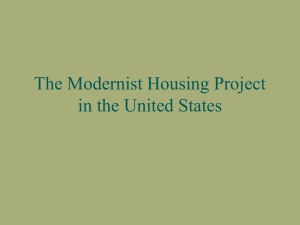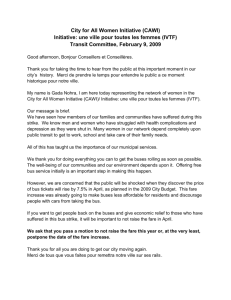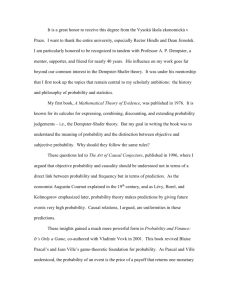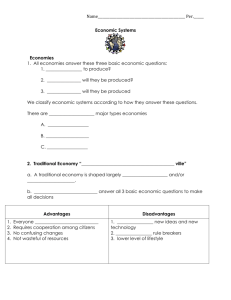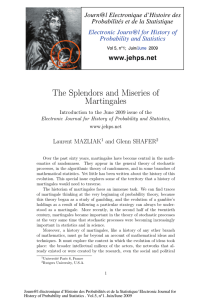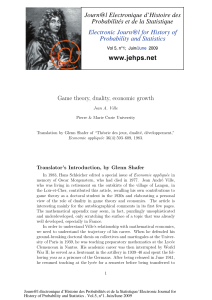Jean Ville’s recollections, in 1984 and 1985, Reported by Pierre Cr´epel
advertisement
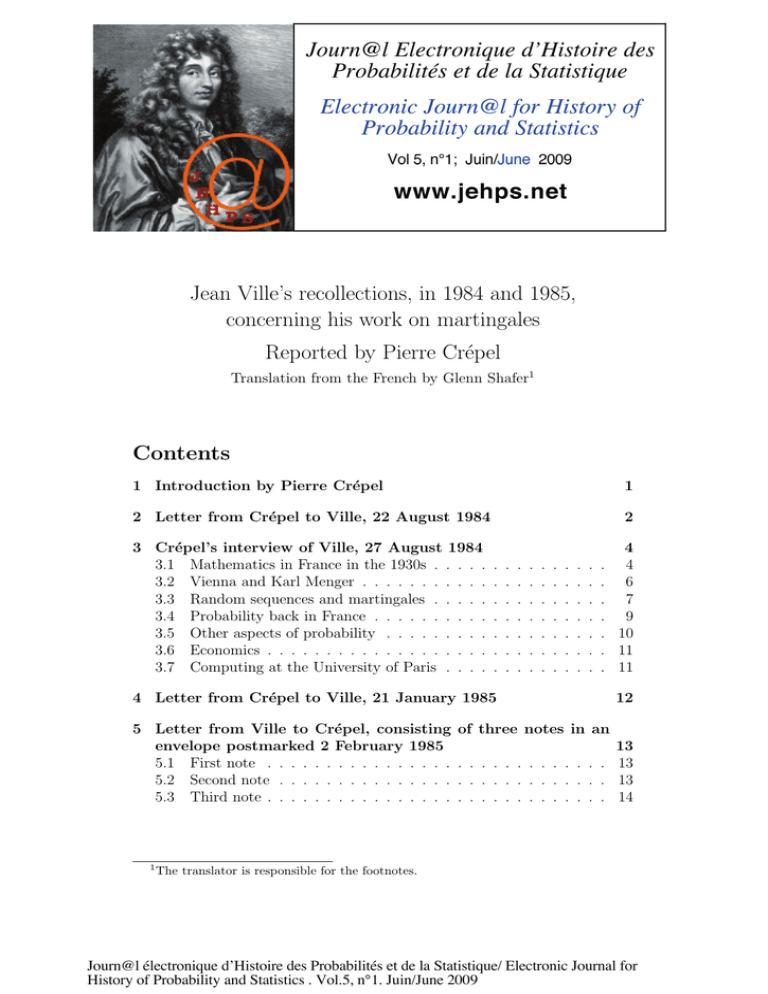
Jean Ville’s recollections, in 1984 and 1985,
concerning his work on martingales
Reported by Pierre Crépel
Translation from the French by Glenn Shafer1
Contents
1 Introduction by Pierre Crépel
1
2 Letter from Crépel to Ville, 22 August 1984
2
3 Crépel’s interview of Ville, 27 August 1984
3.1 Mathematics in France in the 1930s . . . . .
3.2 Vienna and Karl Menger . . . . . . . . . . .
3.3 Random sequences and martingales . . . . .
3.4 Probability back in France . . . . . . . . . .
3.5 Other aspects of probability . . . . . . . . .
3.6 Economics . . . . . . . . . . . . . . . . . . .
3.7 Computing at the University of Paris . . . .
4
4
6
7
9
10
11
11
.
.
.
.
.
.
.
.
.
.
.
.
.
.
.
.
.
.
.
.
.
.
.
.
.
.
.
.
.
.
.
.
.
.
.
.
.
.
.
.
.
.
.
.
.
.
.
.
.
.
.
.
.
.
.
.
.
.
.
.
.
.
.
.
.
.
.
.
.
.
4 Letter from Crépel to Ville, 21 January 1985
5 Letter from Ville to Crépel, consisting
envelope postmarked 2 February 1985
5.1 First note . . . . . . . . . . . . . . . .
5.2 Second note . . . . . . . . . . . . . . .
5.3 Third note . . . . . . . . . . . . . . . .
1
12
of three notes in an
13
. . . . . . . . . . . . . 13
. . . . . . . . . . . . . 13
. . . . . . . . . . . . . 14
The translator is responsible for the footnotes.
Journ@l électronique d’Histoire des Probabilités et de la Statistique/ Electronic Journal for
History of Probability and Statistics . Vol.5, n°1. Juin/June 2009
1
Introduction by Pierre Crépel
As a mathematician doing research in the 1970s, I was particularly interested
in the connections between random walks on groups and limit theorems for
dependent variables. At the beginning of the 1980s, Jean-Luc Verley, sadly
recently deceased but then in charge of mathematics for the Encyclopaedia
Universalis, asked me to write the encyclopedia’s article on martingales. One
usually begins this kind of article with a short historical introduction, and
my inability to do this well pushed me to look more closely at the beginnings
of martingale theory, which the mathematical folklore attributed to Joseph
Louis Doob.
In fact, though Doob did indeed develop the concept of a martingale
and reorganize whole branches of the probability calculus using it, he never
pretended to be the first to introduce the concept or the name into modern, post-Kolmogorov, probability theory. Moreover, his pioneering article of
1940, “Regularity properties of certain families of chance variables,”2 referred
to Jean Ville’s thesis, “Etude critique de la notion de collectif,” defended and
published in 1939.
No doubt the word and/or the thing, or a least closely related ideas,
had been around for a long time, at least since the 18th century, in what
was called the probability calculus. In the 20th century, certainly, Louis
Bachelier, Serge Bernstein, and Paul Lévy had proven interesting results on
convergence that we recognize today as theorems about martingales, but it
appears that Chapter V of Ville’s thesis is the first place where we find all
three elements explicit and together: the definition, the name, and an almost
sure limit theorem.
Bernstein died in 1968, Lévy in 1971. So when I decided to work on the
history of martingales, I was especially interested in getting in touch with
Ville and Doob.
Ville had been retired for only a few years, and many people at the Faculty
of Sciences in Paris had known him, but he no longer had any relations at
all with the probability department, and I was told he was “dead.” No one
being able to give me a date or show me an obituary, I was skeptical, and I
ended up finding him quite alive at Langon, a village in the Loir-et-Cher in
the center of France, where he had retired.
I then got in touch with Michel Vacher, a retired physics professor from
the University of Rennes whom I knew, who had also retired to Langon. He
confirmed that Jean Ville and his wife lived in a hamlet in the district and
were known there. So I simply telephoned Ville. He was very friendly and
gave me an appointment to see him in the summer. Then on 22 August 1984,
I wrote a letter telling him the sort of questions that I wanted to ask, and
on the 27th I appeared as he had invited me to do.
I should emphasize that there were no university centers for the history
2
Transactions of the American Mathematical Society 47:455–486.
1
Journ@l électronique d’Histoire des Probabilités et de la Statistique/ Electronic Journal for
History of Probability and Statistics . Vol.5, n°1. Juin/June 2009
of science in France at the beginning of the 1980s. History of mathematics
was practiced, for the most part, either by philosophers or on an amateur
basis by mathematicians, who might or might not still be doing mathematics. I had absolutely no training as a historian, which partly explains the
unquestionably naive character of my questions.
At the end of 1984, I recorded what I had learned by reading the mathematical literature (mainly works by Bernstein, Lévy, Ville, and Doob), together with miscellaneous information I had gathered on the history of martingales up to 1940, in an article that remained unpublished, part of the
“gray literature,” namely, “Quelques matériaux pour l’histoire des martingales,” Séminaires de probabilités de l’Université de Rennes 1, 1984, 65 pp.3
I had planned to continue my work in at least two directions: first the
connections with analysis and harmonic functions (I had already began this
work by corresponding with Doob and talking with Paul-André Meyer), and
second the use of martingales and related concepts in mathematical statistics and its applications. This is mentioned at the end of my article. But
after 1985, as a good many of the historians of science in France were progressively caught up in the bicentennial of the French Revolution, Roshdi
Rashed pushed me to study probability in Condorcet’s work. This I did,
abandoning the history of martingales.
Pierre Crépel
6 January 2008
2
Letter from Crépel to Ville, 22 August
1984
Dear Mr. Ville,
Let me begin by thanking you for agreeing to see me. The time we agreed
on, Monday, August 27, around 2:00 pm, is perfectly convenient for me.
I have already explained a bit the purpose of my visit. I am a researcher
at the CNRS,4 a probabilist by education. In 1977 I defended a thesis on
random walks with values in locally compact groups. Now I am working
on a topic in the history of mathematics: the theory of martingales in the
1930s and 1940s. I have a wide variety of questions, because in my view,
the history of science should not neglect any angle of attack. In addition to
looking at a topic from inside the particular discipline, we should also look
Available in the section on history of probability at www.probabilityandfinance.
com.
4
The CNRS (Centre National de la Recherche Scientifique) is a branch of the French
government. It engages in research in all scientific disciplines, employing tens of thousands
of scientists full-time in laboratories spread across France, many of them attached to
universities. Crépel was located at the University of Rennes at this time.
3
2
Journ@l électronique d’Histoire des Probabilités et de la Statistique/ Electronic Journal for
History of Probability and Statistics . Vol.5, n°1. Juin/June 2009
at its scientific, philosophical, socio-economic, and cultural aspects, and so
on. Here are a few questions; I am sure our discussion will produce more.
• What did “martingale” mean to probabilists of the 1930s? Were there
treatises devoted especially to games of chance? At what point did the
word come into mathematical usage?
• What topics were discussed in Karl Menger’s colloquium? What was
the atmosphere? What questions were considered important? What
importance did Vienna have in the world of ideas in general and for
probability in particular? Did people like Popper participate?
• It seems to me that Abraham Wald played a rather central role in the
evolution of probability and statistics in the 1930s and 1940s. What
do you think? Weren’t sequential analysis, stopping times, and martingales all connected? To what extent was this clear in people’s minds
at the time?
• Why was the notion of a collective so important in the 1930s? Why
were probabilists writing so much philosophy? How was Kolmogorov’s
contribution, especially his 1933 book, received and experienced?
• Why and how did the center of theoretical probability shift towards
the United States between 1930 and 1950 (emigration, result of the
war,. . . )? Were you well acquainted with Doob, Feller, . . . ?
• More generally, how would you explain the particularities of the “national schools” (if this expression is appropriate) of probability and
mathematical statistics: French, English, American, Russian, German,
Austrian. . . ?
• Did people talk about the schools of economists (for example, Keynes,
Tinbergen, Koopmans, Morgenstern, Friedman, Wallis. . . ) and their
connections with probability and statistics? How and why did operations research evolve in the 1930s and 1940s, and how was this evolution
related to probability and statistics?
• In your May 1955 summary of your scientific work, you say this about
martingales: “I was calling mathematicians’ attention to an idea that
existed already, because the word existed, but had not been considered
important.” Looking backwards, one has the feeling that the need
for this notion was felt to a greater or lesser extent in many different
branches of analysis, but that mathematicians had not succeeded in
bringing it to the surface. I am thinking of Jessen, of Marcinkiewicz. . . .
So how were analysts and probabilists connected at the time (is this
even a well posed question)?
3
Journ@l électronique d’Histoire des Probabilités et de la Statistique/ Electronic Journal for
History of Probability and Statistics . Vol.5, n°1. Juin/June 2009
• From a philosophical point of view, isn’t the emergence of the idea of a
martingale in probability theory linked indirectly to a new step in the
conception of time?
I will stop here, because I could go on and on; there are so many questions.
Impatient to meet you, I offer my best greetings.
Pierre Crépel
3
Crépel’s interview of Ville, 27 August 1984
When I arrived at Jean Ville’s home, he was dressed more or less like a
gardener, and he received me under a little arbor, in front of a pond where
a great number of geese and ducks were splashing about. The homestead
was fairly large and disordered. J. Ville told me that he would not ask me
to come in the house, where the disorder was even worse and his wife was
rather indisposed. He talked with me very straightforwardly, without guile
or pomposity. He gave me several documents that he had found for me in his
papers, including a report on his articles and work.5 The conversation lasted
about two hours. I took fairly detailed notes, but not knowing shorthand, I
was obviously unable to take it all down. The translator and I have composed
the following text from these notes. We have put it in the third person to
avoid leaving the impression that Ville’s exact words are being translated.
Pierre Crépel
6 January 2008
3.1
Mathematics in France in the 1930s
Looking back 50 years, Ville saw France in the 1930s as a black hole for the
mathematical topics he found most interesting. There were incredible gaps.
Boolean algebra, for example, was almost never taught. Neither probability
theory nor set theory were taken seriously. David Hilbert’s work in logic was
hardly known. Ville learned about existence of propositional functions only
from a Romanian student, Barbalat, who wanted to do a thesis on the topic.6
An English translation, “Summary of the scientific works of Mr. Jean Ville (May
1955)”, appears in this issue of the Electronic Journal for History of Probability and
Statistics.
6
I am grateful to Marius Iosifescu and Solomon Marcus, of the University of Bucharest
and the Romanian Academy of Sciences, for information on Ion Barbalat. Barbalat was
born on 20 January 1907 in Barlad, Romania. He became a student at the University of
Paris in 1926. He and Ville were among the six students who took the examination for
the Diplôme d’études supérieures in probability theory in March 1931. He returned to
Romania later that year. After completing his military service, worked for an insurance
company, and taught at the secondary and university level. His earliest publications,
following World War II, were in foundational topics, but he is best known for Barbalat’s
5
4
Journ@l électronique d’Histoire des Probabilités et de la Statistique/ Electronic Journal for
History of Probability and Statistics . Vol.5, n°1. Juin/June 2009
There was work on geometry and complex analysis in Paris. Ville did
not like complex analysis; he saw it as a bit miraculous but not at all stable. Fréchet was the grand master of topology, of course. But the rigorous
exposition of topology was yet to come.
Fréchet wanted Ville to do a thesis on what could be done with two
abstract spaces, perhaps a space of sequences and a Hilbert space. Ville
found nothing.
To make probability dynamic, you had to discretize time, as in Borel’s
denumerable probability and Cantelli’s strong law of large numbers, topics
Fréchet had in the curriculum for the Diplôme d’études supérieures in probability theory.7 Markov chains were unknown to the Paris faculty.8 Bachelier was completely unrecognized in France, though Czuber had cited him;
his work did not appeal to Fréchet, who took offense at probabilities being
treated so lightly.
Fréchet did not believe that there is only a single mathematical foundation
for probability.9 He was interested in von Mises but also enthusiastic about
Kolmogorov. He distinguished events that are probabilizable from those that
are not.10 This was interesting only for mathematical technicians. Borel was
interested in the imitation of chance—pseudo random events.11
The graduates of the Ecole Normale Supérieure were platoon leaders in
the infantry in World War I. The school’s annual directory shows what massacres befell the classes who had entered in 1912, 1913, 1914, and 1915. It
was not as bad later. At first the high command had no idea what they were
doing. It took them at least two years to figure it out.12
lemma, about the stability of dynamic systems. He became a full professor in 1963 and
finally earned a doctoral degree in Romania in the 1970s. See History of Mathematics in
Romania, III:274–277, 1967.
7
Ville earned this degree in 1931, after two years at the Ecole Normale and the University of Paris.
8
This sentence is not accurate. Fréchet was already enthusiastic about “événements en
chaı̂ne” in the early 1930s (see Bernard Bru’s Souvenirs de Bologne, Journal de la Société
Française de Statistique 144:134–226, 2003). The topic was even treated in the course
Ville took from Fréchet.
9
In a lecture he delivered in 1925 and published in 1955 (Les mathématiques et le
concret, Presses Universitaires de France, Paris, pp. 1–10) Fréchet argued that for some
purposes probability should be “de-axiomatized.”
10
Fréchet was still using “probabilizable” instead of “measurable” after World War II.
See, for example, “On two new chapters in the theory of probability,” Mathematics Magazine 22:1–12, 1948.
11
One of Borel’s many notes on this topic appeared as an appendix to the book on
games of chance that Ville wrote up from Borel’s lectures. Another appeared in 1937 in
the (Comptes rendus (204:203–205).
12
Ville may be trying to explain the lack of energy in mathematics in Paris in the 1930s.
Top students like Ville are often mentored by mathematicians ten to twenty years their
senior. But so far as probability was concerned, this generation was missing. Borel and
Fréchet were more than thirty years older than Ville.
5
Journ@l électronique d’Histoire des Probabilités et de la Statistique/ Electronic Journal for
History of Probability and Statistics . Vol.5, n°1. Juin/June 2009
3.2
Vienna and Karl Menger
In 1933 Ville went to Berlin, to pursue his thesis topic in analysis and also
to study von Mises’s definition of probability. He did not find anyone there
working on either topic,13 so he studied the work of Carathéodory, which
he found unpretentious and very clear, with privatdocents. He quarreled by
letter with Fréchet, who was angry that he had not produced anything that
could be published in the Comptes rendus of the Academy of Sciences.
Out of desperation, not knowing where to go after Berlin, Ville went to
Vienna. Vienna had great liberty of thought. It was in full decadence in the
1930s.
Karl Menger, who had done dimension theory, was in Vienna. So was
Carathéodory. Karl Menger was the son of the great Menger—the distinguished economist Carl Menger who studied marginal value. There were
also other famous Mengers.
At one point Karl Menger hosted Ville at a small inn in Kitzbühel,14
where they talked a good deal. There Menger explained to Ville the main
fault of French education: its extraordinary pedanticism. The student is so
regimented by special mathematics that he doesn’t dare do anything.15
Menger also told Ville about a theorem of Sierpinski’s: two unequal balls,
say one a millimeter in diameter and the other a kilometer in diameter, can
be decomposed into a finite number of congruent three-dimensional sets.16
He interested Ville in formal logic by telling him about Gödel. Menger had
studied with Brouwer in Holland. Ville had already read a bit of Lord Russell.
Two entire volumes of symbols to show that there are infinitely many prime
numbers!
Menger’s seminar, the Mathematisches Kolloquium, met once a week,
with a dozen people coming on the most crowded days. In the seminar,
they called Ville “Mr. Student,” or the “King of Counterexamples,” because
he found counterexamples to the supposed theorems of an American named
Blumenthal who was in Vienna at the time.17
Von Mises fled from Berlin to Istanbul shortly after Hitler came to power early in
1933.
14
Kitzbühel is over 350 kilometers from Vienna.
15
Instead of going directly to the university, the best French students continue their
secondary education for two more years, to prepare for entrance competitions for elite
schools such as the Ecole Normale Supérieure. The mathematics taught during these two
years is advanced but still taught in the style of secondary education. In Ville’s time,
the mathematics in the first year was called mathématiques spéciales préparatoires; the
mathematics in the second year was called, as it is now, mathématiques spéciales.
16
This is proven by Stefen Banach and Alfred Tarski in “Sur le décomposition des
ensembles de points en parties respectivement congruentes,” Fundamenta Mathematicae
6:244–277, 1924.
17
Ville’s first publication, in Menger’s Ergebnisse, was a noted intitled, “Sur une proposition de M. L. M. Blumenthal.” Leonard M. Blumenthal (1901–1987) continued to work
on distance geometry after he returned to the United States. He was chairman of the
Department of Mathematics at the University of Missouri for many years. Ville could not
13
6
Journ@l électronique d’Histoire des Probabilités et de la Statistique/ Electronic Journal for
History of Probability and Statistics . Vol.5, n°1. Juin/June 2009
Tarski was in Vienna, working on Lukasiewicz’s three-valued logic. Gödel
was also there. Reichenbach was a professor in Istanbul. Menger thought
parentheses were useless. He gave a lecture explaining Lukasiewicz’s “Polish
notation,” which eliminates them. One can write the operator in front of its
arguments: ×ab. In general, it is better to reverse this: abc × ×. All this
comes back in machine computation, as Ville realized much later: A + B
becomes SAB, A + B + C becomes SSABC, etc. The seminar also learned
about Bergmann’s axioms of incidence for n-dimensional geometry.18
Wald did a bit of everything in the seminar. He lived with his brother,
who repaired radios in the Marienfeldstrasse. He was from Transylvania,
which had been part of Hungary before it was invaded by Romania.19
Economics probably interested Wald most. Gérard Debreu later had a
stunning success with his theory of economic equilibrium, showing how a
price system is determined by utility functions as a fixed point, where no
one finds any advantage in trading. Wald had already done this in a more
classical framework. Ville had read the articles on economics in the old
mathematical encyclopedia.20
Georges Alexits, ten years older than Ville, wanted to construct torsion
with respect to Wald’s total curvature in dimensions greater than three, but
this did not work out.21
None of the young people in the seminar had a dime. Ville was able to
be there because of an Arconati-Visconti scholarship.22
3.3
Random sequences and martingales
The idea of a random sequence interested people. Von Mises was one of many
who had his own definition.
remember Blumenthal’s name; he thought it might have been Rosenblum or Rosenblatt.
18
This sentence is my interpretation of Ville’s passing reference to “connecteurs de
Rosen. . . .” Gustav Bergmann (1906–1987), a member of the Vienna Circle, later became
a professor of philosophy at the University of Iowa. Menger and Alt discussed Bergmann’s
work in Menger’s seminar in January and February of 1935. The French “connecteur”
was sometimes used to translate Hilbert’s “Verknüpfungsbeziehungen,” which names an
operation that produces a point from two lines or a line from two points, etc.
19
Wald’s hometown Cluj was in a portion of Transylvania occupied by the allies in
World War I and transferred from Hungary to Romania by the Treaty of Trianon in
1920. According to Menger (Annals of Mathematical Statistics 23:14–20, 1952), Wald had
carried out most of his studies at the elementary and secondary school level under the
direction of his older brother Martin, a capable electrical engineer. According to Jacob
Wolfowitz (Annals of Mathematical Statistics 23:1–13, 1952), Martin had many inventions
to his credit. He and most of the rest of the family perished under the Nazis.
20
The Encyclopédie des sciences mathématiques pures et appliquées, published beginning in 1906, was an expanded French version of the earlier German Encyklopädie der
mathematischen Wissenschaften.
21
Georges Alexits, “La torsion des espaces distanciés,” Composito Mathematica 6:471–
477, 1939.
22
In his conversation with Crépel, Ville said “Asconati.” He made the same error on a
number of other occasions.
7
Journ@l électronique d’Histoire des Probabilités et de la Statistique/ Electronic Journal for
History of Probability and Statistics . Vol.5, n°1. Juin/June 2009
Karl Popper proposed “nachwirkungsfreie Folgen,” sequences with no aftereffect. For him, probability was a sequence of frequencies; he wanted
sequences in which 0 had probability 1/2, while 00, 01, 10, and 11 had probability 1/4, and so on. The work on this idea did not get very far.23
For Wald, a random sequence was one in which the selection of a subsequence does not change the frequency. This led quickly to logic. According
to Wald, a selection rule had to be defined by a finite number of symbols,
and this depends on the algebraic formalization. Given a particular formalization, Wald could form a collective, making von Mises’s theory rigorous. “I
can tell Fréchet it is finished,” Wald said. “Too bad for me,” Ville thought
to himself.
Ville spent hours and hours constructing sequences with regular patterns
of zeros and ones satisfying Popper’s conditions: 00011101, etc. (Someone
named Posthumus later showed that this could be done using mere arithmetic.)24 Ville obtained a sequence that respected Wald’s condition but gives
preference to 1, approaching the frequency 1/2 from above. This event has
probability zero under classical probability theory, and so Wald’s conditions
are not sufficient to represent the classical theory.
It was at this point that Ville tried the notion of a martingale. He thought
“martingale” might be an Italian name.25 The martingale is the gambling
system that tells you to double your bet every time you lose. Or rather, any
system that permits the player, if and when he finally wins, to regain all the
money previously bet. The word was associated with a classical argument
for all gambling systems being illusory. Time would have to be infinite.
Governments engage in such illusions nowadays.
A martingale must tell how much of your money to risk and how much
to keep on each round, as a function of what has happened before. The
expectation should be the same with or without such a system of play. Ville
After hearing a semi-technical exposition of Popper’s ideas in Moritz Schlick’s seminar
(the “Vienna Circle”), Menger asked Popper to present them in detail in his seminar, and
Wald became greatly interested.
24
Consider the sequence 00011011, arranged in a circle (the first 0 following the last
1) to form a cycle. Each of the eight possible triplets (000, 001, etc.) occurs exactly
once in the cycle. There are exactly 16 cycles of length eight with this property. Around
1944, the well known Dutch engineer Klaus Posthumus (1902–1990) conjectured that in
general the number of cycles of length 2n that have each of the 2n possible sequences
n−1
of length n occuring exactly once is 22 −n . In 1946, N. G. de Bruijn proved the
conjecture (“A Combinatorial Problem,” Koninklijke Nederlandse Akademie v. Wetenschappen 49:758–764, 1946, available from www.win.tue.nl/~wsdwnb/). In 1950, N.
M. Korobov showed that the result can be used to construct sequences satisfying Popper’s conditions (Izvestiya Akad. Nauk SSSR 14:215–238 and Uspehi Matem. Nauk (N.
S.) 5(3)(37):135–137). De Bruijn subsequently discovered that his result had been obtained by others much earlier. He discussed the history of the problem in 1975 in T.H.Report 75-WSK-06, Department of Mathematics, Technological University Eindhoven,
http://alexandria.tue.nl/repository/books/252901.pdf.
25
For a discussion of the origins of the word, see the article by Roger Mansuy in this
issue of the Electronic Journal for History of Probability and Statistics.
23
8
Journ@l électronique d’Histoire des Probabilités et de la Statistique/ Electronic Journal for
History of Probability and Statistics . Vol.5, n°1. Juin/June 2009
looked for simple martingales that can prove complicated theorems.
Ville found a simple martingale for the game of heads and tails. A player
starting with unit capital with this martingale has
α!β!
p−α q −β
(α + β + 1)!
after α tails and β heads. This being bounded implies that the frequency of
heads tends to p at a logarithmic rate.26 The people in Vienna liked this,
but none of them were professional probabilists.
Schnorr’s Lecture Notes no. 21827 should be read. It talks about Ville’s
collective. The more complicated a probability law, the longer it takes to
describe the martingale that would make it happen. See Kolmogorov.
People did not appreciate sequential analysis until they did quality control.
3.4
Probability back in France
Fréchet had a hard time understanding Ville’s results. Borel said to Ville:
When are you going to decide to do analysis?
Paul Lévy did not read his thesis. “I don’t read,” he told Ville.28 Aside
from his aversion to reading other mathematicians, Lévy was displeased that
Ville’s thesis had been printed by the Rendiconti del Circolo Matematico di
Palermo. “You had your thesis printed by the fascists,” he objected. “I
didn’t have any money,” Ville responded.
Fellow students included Wolfgang Doeblin, Michel Loéve, Félix Rosenfeld, and Robert Fortet. Doeblin was not at all a pedant. In 1938–39, Ville
and he began a seminar on probability,29 which was soon anschlussed by
Borel.30 Loève was from Egypt, from a Russian family who had taken refuge
there after the Russian Revolution. Rosenfeld was a statistician. Fortet was
excused from military service. He worked on the theory of heat. He thought
of probability as a fluid; when an event happens it gives probabilities to other
events.
See section 3 of chapter V of Ville’s Etude critique. The system of play is to risk the
fraction (a + 1)/(a + b + 2) of your capital on tails on the next round when you have a
tails and b heads so far; the rest on heads. Because the capital is always nonnegative, it
will be bounded with probability one.
27
Claus-Peter Schnorr, Zufälligkeit und Wahrscheinlichkeit, Lecture Notes in Mathematics, Vol. 218, Springer, 1971.
28
Lévy’s explained his unwillingness and even inability to read the work of other mathematicians in his autobiography, Quelques aspects de la pensée d’un mathématicien, Blanchard, Paris, 1970.
29
The correct date is surely 1937–38. In 1938–39, Ville was busy five days a week
teaching in the lycée at Nantes, and Doeblin was doing his military service. Documents in
the Doeblin archives at Marbach indicate that Doeblin made presentations in the seminar
in 1937.
30
Here Ville used the invented French verb anschlusser. After Hitler’s Anschluss of
Austria in March 1938, the word was used as a verb in French and other languages.
26
9
Journ@l électronique d’Histoire des Probabilités et de la Statistique/ Electronic Journal for
History of Probability and Statistics . Vol.5, n°1. Juin/June 2009
In Poitiers, where Ville taught during the war, there was no probability.
Not much was going on. It was much more hierarchical then. People were
occupied with their everyday business. There was not much scientific research
in France during the war, except for the Germans.
3.5
Other aspects of probability
Conditional probability is essential for writing down a martingale. What
is a conditional probability? It is in the rule P (AB) = P (A)P (B|A). A
martingale is the quotient of a false conditional probability by the true one:
P (x if y)
.
P0 (x if y)
It’s very simple.
There was no talk about R. A. Fisher in Vienna. We should expect not
an outcome with nearly maximum likelihood, as Fisher suggested, but an
outcome with likelihood close to average.31 But the calculations are impossible.
Ville became upset with his colleagues at Lyon in 1947, when he was
passed over for a vacant post; he was ranked second, after the person appointed. So he took a leave of absence.32 He worked in the electrical industry
and threw himself into working on quality control and signal theory at the
Société Alsacienne de Constructions Mécaniques.
Shannon information came along. Shannon had not been in contact with
Vienna, but his ideas were close to those explored in Menger’s seminar. Ville
worked on random coding, which is easier than algebraic coding, and on
Monte Carlo methods. He studied the problem of removing mines. You have
to look at the probability they are laid and the probability the adversary
passes through. This leads to game theory.
The Wiener lattice and the probability calculus: Write the matrix equation A2 = A instead of the equation x2 = x, which has only 0 and 1 as
solutions.
The Americans took the lead in operations research. Claude Berge did
graphs and networks, but these topics came late to France; things like that
were not done in France before the war.33
Average in the sense of the geometric mean. Ville spelled this idea out on pp. 92–95
of his “Leçons sur quelques aspects nouveaux de la théorie des probabilités,” Annales de
l’Institut Henri Poincaré 14:5–143, 1954–1955.
32
In 1946, Gustave Malécot, mathematical geneticist and student of Darmois, was appointed to the vacant chair of rational mechanics that Ville had been filling temporarily.
Ville’s leave of absence, effective retroactively to October 16, 1946, was not granted officially until March 1947.
33
Berge’s doctoral thesis, “Sur une théorie ensembliste des jeux alternatifs,” J. Math.
pures et appl. 32:129–184, 1953, was cited by Ville in the article cited in the preceding
footnote.
31
10
Journ@l électronique d’Histoire des Probabilités et de la Statistique/ Electronic Journal for
History of Probability and Statistics . Vol.5, n°1. Juin/June 2009
People had long believed that the first bullets in a burst of gunfire are the
most dangerous; the end of the burst is wasted. By numbering the bullets,
operations researchers found that the opposite is true.
The Americans had a more open conception of mathematics. The success
of modern algebra is due to them. The flowering of Bourbaki also owes a lot
to them. They published many books on such topics.
French mathematics lost its originality during the war. It was hard just to
find a place to live. It was hard to pass between the occupied and unoccupied
zones.
Ville knew Doob and Feller only by their books. He had no relation with
them or with von Neumann. Feller was both a probabilist and an analyst.
He was interested in properties of independent normal random variables.
3.6
Economics
Von Neumann was the great man in economics. It gave Borel fits not to have
proven the fundamental minimax theorem.
Ville had never taught probability in his life before doing so in econometrics.34 In econometrics, he studied matrices of positive numbers—weighted
sum of permutation matrices. He was also interested in preference orderings.
Price theory can be substituted for value theory. Dual prices are important.
An Arab economist wrote a book on prices in the Soviet Union, based
on the mathematics of the Russian school.35 Ville wrote an article about
this around 1976 in the newspaper Le Monde. But people told him: The
Russians only pretend to do mathematical economics.
Leontief’s technology matrices are still not properly understood.
3.7
Computing at the University of Paris
The French computer company Bull, under Philippe Dreyfus, loaned a computer to the University of Paris. Georges Darmois said to himself, perhaps
we should get that franc-tireur Ville to work on it. They were infernal, those
computers with lamps.
Ville knew the pioneers of computer science in France. The Société Alsacienne de Constructions Mécaniques (SCAM) was located on the street
named for Admiral Mouchez.
How do you decide whether to reject a cable? You are playing a game
against the computer’s breakdown.
Ville also worked with the Compagnie Générale d’Electricité (CGE),
which merged with part of SCAM and evolved into Alcatel. He did not
34
This statement overlooks his having taught probability as a prisoner of war in the
second world war.
35
The Egyptian economist Mahmoud Abdel Fadil, who earned a doctorate at the University of Paris I in 1972, published La planification des prix en économie socialiste : essai
methodologique in 1975.
11
Journ@l électronique d’Histoire des Probabilités et de la Statistique/ Electronic Journal for
History of Probability and Statistics . Vol.5, n°1. Juin/June 2009
know what exactly Alcatel had become.
4
Letter from Crépel to Ville, 21 January
1985
Dear Mr. Ville,
To begin, I send my best wishes for 1985, wishing good health for you
and all those dear to you.
For the past few months I have been working on the history of martingales
before the war, and I have completed writing up a presentation I made on the
subject for the probability seminar at Rennes. Before having the secretary
type it, I am sending you the part that concerns your work. If you find errors
or omissions, don’t hesitate to let me know, so that I can correct them. Of
course I will also send you the whole thing once it is typed.
While thinking about the topic, I have thought of further questions to
ask you:
• What effect did Kolmogorov’s book, the Grundbegriffe, have on people
in Vienna in 1934–35, and on Wald, Popper, and yourself in particular?
Was it discussed in Karl Menger’s seminar, and if so how?
• At the 1937 Vienna colloquium (at least in the written version of his remarks, dated 1938), well before your thesis appeared, Maurice Fréchet
explained its results in some detail. I conjecture that you were not
in Geneva in 1937. Were you invited? Do you know whether Fréchet
actually talked about your work there (or did so only in his written
contribution), and if so, what was the reaction of the participants?
• A related question: What was your relationship with Wald at Vienna
and after you returned to France? Reading the summary of the Geneva
colloquium, I got the impression that he did not agree with your objection to von Mises.36
• When did you notice the connections between your ideas and those
of Paul Lévy on “chains of variables”? Were you immediately aware
of the notes he published in the Comptes rendus of the Academy of
Sciences while you were in Vienna (volume 199 in 1934 and volume 201
in 1935)?
The summary, written by Bruno de Finetti (Compte rendu critique du colloque de
Genève sur la théorie des probabilités, Hermann, Paris, 1939), quotes Wald’s response to
various criticisms, including Fréchet’s report that his student Ville had demonstrated that
not all properties with probability one can be represented by subsequence selection rules.
Without specifically mentioning Ville or martingales, Wald reiterated that his approach
allows the construction of a sequence satisfying any countable set of properties of probability one (p. 15). This is true whether the properties are specified by subsequence selection
rules, by martingales, or in some other way.
36
12
Journ@l électronique d’Histoire des Probabilités et de la Statistique/ Electronic Journal for
History of Probability and Statistics . Vol.5, n°1. Juin/June 2009
• I found a 1936 article by Doob entitled “Note on probability” (Annals of Mathematics 37, 1936, pp. 363–367), where he demonstrated
mathematically the impossibility of a gambling system (one that merely
chooses trials on which to bet, without varying the stakes) in the case of
independent trials. Did you read this article, and what did you think of
it? The same question for Paul Halmos’s “Invariants of certain stochastic transformations in the mathematical theory of gambling systems”
(Duke Mathematical Journal 5, 1939, pp. 461–478), which extends the
demonstration to the martingale case.
• Finally, I noticed that Doob and yourself each wrote an article for the
colloquium at Lyon (28 June–3 July 1948) on the probability calculus
and its applications. Were you actually there together, and did you
encounter each other?
Of course I will also be grateful for any other information you think might
be useful to me.
I offer my best respects and renew my wishes for a good new year.
Pierre Crépel
5
5.1
Letter from Ville to Crépel, consisting of
three notes in an envelope postmarked 2
February 1985
First note
I am late responding to your letter. Like many others, we were taken by
surprise by the extreme cold. Then it got worse. A large portion of the
water pipes here gave out, and an equally large portion of the electric lines.
There will be a big bill.
Catastrophes of this sort, and a good many other kinds of bad luck (such
as these interminable lawsuits, rotten from the outset because of the state of
our legal system), are never taken into account when pension payments are
set.
More exactly, pensions are set so that someone else has to take responsibility for these things. This is just what was explained to me by Mr. Vessiot,
director at the Ecole Normale Supérieure when I was there.
5.2
Second note
Dear Mr. Crépel,
Thank you for the documents you sent. I attach a more detailed letter,
to avoid prolonging this one indefinitely.
13
Journ@l électronique d’Histoire des Probabilités et de la Statistique/ Electronic Journal for
History of Probability and Statistics . Vol.5, n°1. Juin/June 2009
You make me remember a time when we pondered the meaning of probability, sensing its impending importance.
Fréchet favored: “Probability = physical quantity, measured empirically
by the frequency of outcomes in a sequence of trials.” P. Lévy favored a
more ethereal definition. The students did not have a preconceived opinion. Fréchet would have been persuaded by von Mises, but like everyone
raised a trivial objection against him. One should not consider all selection
rules. This is where the disagreement was in the end. Logic was beginning to
be fashionable, and “Bourbakism” had been launched. People were fussing
about the meaning of “it exists.” The logicians thought they were addressing
the problem by writing ∃. People talked about “constructivity.” Algorithms
were not popular. But this is really the idea we have in our heads, as developed by Claus Peter Schnorr (Zufälligkeit und Wahrscheinlichkeit. Lecture
Notes in Mathematics. Edited by A. Dold, Heidelberg, and B. Eckmann,
Zürich, Springer37 ). We sensed the germination of today’s theories based
on algorithms. But this was all muddled for people nourished on Cauchy,
Riemann, and Poincaré.
So the hiatus does not surprise me.
At that time I could not manage to make people understand what I
wanted to say. Fréchet was openly doubtful; he didn’t like the topic. I only
managed to move on with the help of E. Borel. Borel told Fréchet that it
was time to finish with the thing and had it published.
At the time, I had given a proof of the minimax theorem for a zero-sum
matrix game with two players, showing that it was only a question of convexity. Fréchet did not believe it. It was only accepted when J. von Neumann
acknowledged it in Econometrica. (Just as Doob’s acknowledgement gave me
credit for martingales.)
Much later I worked on stochastic processes, using the Wiener-Lévy process. I had already been aware of it, completely by chance, from Bachelier.
Now of course all this is so well known that it seems like part of the nursery
school curriculum.
Renewing all my thanks to you, I ask you, dear Mr. Crépel, to accept the
affirmation of my best wishes.
Jean Ville
5.3
Third note
I and Mrs. Ville thank you for your good wishes. Your care in sifting through
the history of the theory of martingales is meritorious.
Martingales were not the subject of any systematic study in France. People were mainly interested in showing that they were ineffective. But I had an
acquaintance, a relative of the woman who became my wife, who claimed to
37
1971
14
Journ@l électronique d’Histoire des Probabilités et de la Statistique/ Electronic Journal for
History of Probability and Statistics . Vol.5, n°1. Juin/June 2009
make a (modest) living by gambling, which he pursued like a drudge, “working” for hours recording and counting the outcomes of boule or roulette spins,
and then betting according to a calculation that he kept secret. His name
was Mr. Parcot. I claimed that it was impossible for him to win. The probability calculus showed that for simple martingales, everything ended up a
loss. Because the calculus was applied to martingales one by one, the layman
was left with the impression that one could find a crack in the armor and slip
though. Mr. Parcot claimed to have found a crack. I did not try to convince
him; I don’t even remember now if I had an opportunity to do so. I knew
that there was a general refutation of the possibility of winning for sure, but I
went no farther. Mr. Parcot’s continuing profits simply made me think. Why
not? I knew that a certain role was played by confusions between infinitely
small and zero, and between actual and virtual infinity, nothing more. I did
not doubt Mr. Parcot’s good faith, and there was something that pointed
out a path.
You mentioned it in your letter, by the way. I studied the probability
calculus in Laplace, and I found there a way to win in heads and tails if you
know the coin is asymmetric without knowing which side is favored. From
this, I concluded that Parcot had perhaps discovered and taken advantage of
a flaw in the roulette wheel. Taking advantage of a known flaw in a roulette
wheel is child’s play, but taking advantage of the fact, for example, that the
spins are not independent, without knowing exactly how they are dependent,
is another matter. So this is where I was, say in 1932.
There was a lot of talk about the foundations of probability. There was
a fight between the supporters of probability on a single trial (a sequence
of trials being the combination of trials whose individual nature is known
and which we join together) and the supporters of frequency (there is no
probability without repetition, each individual trial being “extracted” from
the sequence). Then there were positions in between.
People mentioned Kolmogorov, nothing more. Admittedly, the Grundbegriffe says nothing about probability.38 Fréchet spoke about “probabilized”
events. As for me, I tried to apply myself to general topology, which was
experiencing a painful birth.
In Vienna, people talked about the Grundbegriffe no more than in Paris.
I do not remember talking about my thesis, or hearing it talked about,
before defending it. The thesis was ready in 1936, but I had difficulties getting
it printed and worked on other subjects. So I cannot tell you anything about
the Geneva colloquium in 1937.39
I did not have any personal contact with Wald after returning to France.
If he did not agree with my objection, my best recollection would be that
it was because he thought von Mises’s axioms, as refined by himself, were
Nothing, that is to say, about the meaning of the word.
In a letter to Fréchet at the time, Doeblin said that Ville would remain in Paris instead
of attending the Geneva colloquium because he was busy finishing Borel’s book on games
of chance. But Ville cited the published proceedings of the colloquium in his thesis.
38
39
15
Journ@l électronique d’Histoire des Probabilités et de la Statistique/ Electronic Journal for
History of Probability and Statistics . Vol.5, n°1. Juin/June 2009
more than sufficient in practice. In any case, I was not working regularly
on probability. I was occupied with electricity, signal theory, Shannon’s
information theory, coding and the detection of errors, etc.
Coming back to martingales, I did not hear Paul Lévy’s work mentioned
in this connection until I was giving a course on signal theory at Toulouse,
where one of my listeners spoke to me about Lévy and martingales. He
told me Lévy had invented them. I corrected him, explaining that Lévy had
worked on dependent variables. In fact, I had talked with Lévy. I had defended the principle of compound probability, Pr{a&b} = Pr{a}×Pr{b if a},
while he defended the definition of conditional probability, which defines this
probability starting with Pr{a} and Pr{a&b} (Fubini and company). Of
course, if one talks about martingales, it is the first of the two approaches
that matters.
Going back even farther, I may point out that probabilities were very
classically linked to games of chance. Think about B. de Finetti, who defined
probability as the inverse of the payment, if the event happens, for staking
1 on the event now.
The article by Doob in 1936 did not hold my attention. The impossibility of winning by choosing trials was far too close to von Mises’s axiom of
selection. As for Halmos’s article, I did not read it. The year 1939 was very
much a year of crisis. By the end of 1938, I had already been mobilized for
several months. I had left my scholarship to take a job teaching the last year
of preparatory mathematics at Nantes in 1938. I realized that the defense of
my thesis was taking forever to happen, and I had decided to take a regular
position. Fréchet did not approve: “A future member of the higher education
profession does not go into secondary teaching.”
Again about Doob. By 1948, because of the attitude of the Lyon faculty
towards me, I had asked for a leave of absence from my position there for
personal reasons. I did not receive any invitation from them; they would not
have had the nerve.40 This is why I never met Doob. Some months later,
someone at the Paris faculty called the matter to my attention, saying, “An
American came to give a lecture at Lyon.”
Again on the topic of the impossibility of a winning martingale, I still
insist on a point that appears obscure to me on your page V 9: “One will
notice the reversal in viewpoint.”41 What is important is not to give a name
to the martingale, but to say how it is defined from what is given. For me,
the Xn are given, and we are to find s1 (X1 ), s2 (X1 , X2 ), etc. Nowadays one
takes as given the Fn and the Zn . There has been an emphasis on the fact
Ville nevertheless contributed an article in the proceedings of the Lyon conference.
Fréchet was the editor.
41
Ville is quoting the draft report on the history of martingales Crépel had sent him. In
the sentence quoted, Crépel contrasts Ville’s definition of a martingale s1 , s2 , . . . (p. 99 of
his book) with Doob’s later definition of a martingale Z1 , Z2 , . . . . Whereas sn is a function
of random variables X1 , . . . , Xn , Zn is a random variable measurable with respect to the
σ-algebra Fn .
40
16
Journ@l électronique d’Histoire des Probabilités et de la Statistique/ Electronic Journal for
History of Probability and Statistics . Vol.5, n°1. Juin/June 2009
that Zn cannot become infinite. My goal, given the Xn and a set to which
the sequence of Xn belongs with probability zero, was to define sn so that
they tend to infinity on that set. I insist on the point because it took me so
long to make this way of proceeding understood.
17
Journ@l électronique d’Histoire des Probabilités et de la Statistique/ Electronic Journal for
History of Probability and Statistics . Vol.5, n°1. Juin/June 2009
